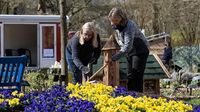As spring unfolds, many gardeners across Germany are feeling the urge to dive into their outdoor spaces, especially after experiencing unseasonably warm temperatures in March that reached up to 20 degrees Celsius. However, experts caution against rushing into gardening tasks, emphasizing that patience is key during this transitional period.
In a recent article, it was noted that while the sunny weather may tempt gardeners to start sowing seeds, doing so too early can lead to disastrous results. The risk of frost returning is a legitimate concern, especially for tender seedlings that could perish if temperatures drop unexpectedly. As such, it is advisable to wait until consistent, warmer temperatures—specifically, stable double-digit readings—are present before sowing lawn seeds.
April marks the beginning of a crucial phase for gardeners, but it is essential to proceed with caution. For instance, verticutting lawns should not commence until at least April, as doing so prematurely can damage newly formed roots. Instead, gardeners can prepare their lawns by removing old leaves and applying fertilizer to promote healthy growth.
For those who prefer to take a more conservative approach, waiting until the Ice Saints period from May 11 to May 15 is recommended. This traditional guideline, derived from historical farming practices, suggests that frost is less likely after this timeframe. The adage, "You are not safe from night frost until Sophie is over," reflects this wisdom.
Interestingly, while some plants like pansies and primroses can tolerate a bit of frost, Mediterranean herbs such as rosemary, sage, and lavender require a more cautious approach. Cutting these herbs back too early can expose new shoots to frost damage, so it is best to hold off on pruning until the risk of cold weather has passed.
Another important consideration for spring gardening is the welfare of local wildlife. The Initiative "Pro Igel" has raised awareness about the potential dangers to hedgehogs if wood or leaf piles are cleared away too soon. Many hedgehogs remain in hibernation until April, and disrupting their nests can leave them vulnerable. Gardeners are encouraged to create small corners and shelters in their gardens to provide safe havens for these creatures.
Moreover, it is also beneficial for insects like butterflies to leave dead plant stalks standing for a little while longer. Some larvae depend on these stalks for shelter as they emerge in the spring. Alternatively, cut plant parts can be gathered into a pile in a corner of the garden, allowing insect residents more time to awaken.
As the discussion around gardening continues, the focus shifts to the Ice Saints, a significant period in May that can bring about a brief but notable cold spell. This annual phenomenon is particularly concerning for gardeners, as late frosts can endanger young plants. Meteorologist Jörg Riemann from the Wettermanufaktur explains that the Ice Saints occur over five consecutive days, with specific dates varying by region. In Northern Germany, the dates are May 11 to May 13, while Southern Germany observes them from May 11 to May 15.
Riemann highlights the relevance of the Ice Saints even today, noting that this period marks the last possible time for frost to occur in a given year. Traditionally, farmers have relied on this rule to guide their planting schedules. However, he cautions that the reliability of this weather pattern has diminished over the years. For instance, in 2023, the Ice Saints did not occur at all, while in 2024, they arrived early.
Looking ahead to 2025, Riemann indicates that the Ice Saints are expected to be early again, as they were in the previous year. Despite this, he reassures gardeners that the risk of significant cold weather later in May is low. By mid-week, with a warming trend anticipated, the danger of night frost should dissipate, allowing gardeners to finally turn on the water in their gardens.
Even if temperatures dip again, Riemann assures that the air will be too warm to cause frost damage. This shift in weather is a welcome relief for gardeners eager to nurture their plants and enjoy the blooming season.
In summary, as spring progresses, it is crucial for gardeners in Germany to remain vigilant and patient. While the allure of warm weather may prompt action, the potential for late frosts and the need to protect both plants and wildlife necessitate a cautious approach. By adhering to traditional gardening wisdom and considering the needs of local fauna, gardeners can create a thriving environment that flourishes throughout the season.






